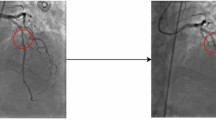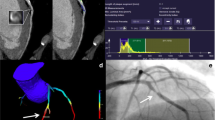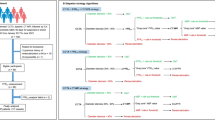Abstract
Fractional flow reserve derived from coronary CT (FFR-CT) is a noninvasive physiological technique that has shown a good correlation with invasive FFR. However, the use of FFR-CT is restricted by strict application standards, and the diagnostic accuracy of FFR-CT analysis may potentially be decreased by severely calcified coronary arteries because of blooming and beam hardening artifacts. The aim of this study was to evaluate the utility of deep learning (DL)-based coronary computed tomography (CT) data analysis in predicting invasive fractional flow reserve (FFR), especially in cases with severely calcified coronary arteries. We analyzed 184 consecutive cases (241 coronary arteries) which underwent coronary CT and invasive coronary angiography, including invasive FFR, within a three-month period. Mean coronary artery calcium scores were 963 ± 1226. We evaluated and compared the vessel-based diagnostic accuracy of our proposed DL model and a visual assessment to evaluate functionally significant coronary artery stenosis (invasive FFR < 0.80). A deep neural network was trained with consecutive short axial images of coronary arteries on coronary CT. Ninety-one coronary arteries of 89 cases (48%) had FFR-positive functionally significant stenosis. On receiver operating characteristics (ROC) analysis to predict FFR-positive stenosis using the trained DL model, average area under the curve (AUC) of the ROC curve was 0.756, which was superior to the AUC of visual assessment of significant (≥ 70%) coronary artery stenosis on CT (0.574, P = 0.011). The sensitivity, specificity, positive and negative predictive value (PPV and NPV), and accuracy of the DL model and visual assessment for detecting FFR-positive stenosis were 82 and 36%, 68 and 78%, 59 and 48%, 87 and 69%, and 73 and 63%, respectively. Sensitivity and NPV for the prediction of FFR-positive stenosis were significantly higher with our DL model than visual assessment (P = 0.0004, and P = 0.024). DL-based coronary CT data analysis has a higher diagnostic accuracy for functionally significant coronary artery stenosis than visual assessment.







Similar content being viewed by others
Data availability
The deidentified participant data will not be shared.
References
Ann SH, Jung JI, Jung HO, Youn HJ (2013) Aortic valve calcium score is associated with coronary calcified plaque burden. Int Heart J 54(6):355–361
Ballegaard CR, Pham MHC, Sigvardsen PE, Kuhl JT, Sorgaard M, Taudorf M, Fuchs A, Nordestgaard BG, Kober LV, Kofoed KF (2022) Aortic enlargement and coronary artery calcification in a general population cohort. Eur Heart J Cardiovasc Imaging 23(6):855–862
Knuuti J, Wijns W, Saraste A, Capodanno D, Barbato E, Funck-Brentano C, Prescott E, Storey RF, Deaton C, Cuisset T, Agewall S, Dickstein K, Edvardsen T, Escaned J, Gersh BJ, Svitil P, Gilard M, Hasdai D, Hatala R, Mahfoud F, Masip J, Muneretto C, Valgimigli M, Achenbach S, Bax JJ, ESC Scientific Document Group (2020) 2019 ESC guidelines for the diagnosis and management of chronic coronary syndromes. Eur Heart J 41:407–477
Koo BK, Erglis A, Doh JH, Daniels DV, Jegere S, Kim HS, Dunning A, DeFrance T, Lansky A, Leipsic J, Min JK (2011) Diagnosis of ischemia-causing coronary stenoses by noninvasive fractional flow reserve computed from coronary computed tomographic angiograms. Results from the prospective multicenter DISCOVER-FLOW (Diagnosis of ischemia-causing stenoses obtained via noninvasive fractional flow reserve) study. J Am Coll Cardiol 58(19):1989–97
Rajiah P, Cummings KW, Williamson E, Young PM (2022) CT fractional flow reserve: a practical guide to application, interpretation, and problem solving. Radiographics 42:340–358
Budoff MJ, Dowe D, Jollis JG, Gitter M, Sutherland J, Halamert E, Scherer M, Bellinger R, Martin A, Benton R, Delago A, Min JK (2008) Diagnostic performance of 64-multidetector row coronary computed tomographic angiography for evaluation of coronary artery stenosis in individuals without known coronary artery disease: results from the prospective multicenter ACCURACY (Assessment by coronary computed tomographic angiography of individuals undergoing invasive coronary angiography) trial. J Am Coll Cardiol 52:1724–1732
Nørgaard BL, Leipsic J, Gaur S, Seneviratne S, Ko BS, Ito H, Jensen JM, Mauri L, De Bruyne B, Bezerra H, Osawa K, Marwan M, Naber C, Erglis A, Park SJ, Christiansen EH, Kaltoft A, Lassen JF, Bøtker HE, Achenbach S, NXT Trial Study Group (2014) Diagnostic performance of noninvasive fractional flow reserve derived from coronary computed tomography angiography in suspected coronary artery disease: the NXT trial. J Am Coll Cardiol 63:1145–55
Hochreiter S, Schmidhuber J (1997) Long short-term memory. Neural Comput 9(8):1735–1780
Vaswani A, Shazeer N, Parmar N, Uszkoreit J, Jones L, Gomez AN, Kaiser L, Polosukhin I (2017) Attention Is All You Need. 31st Conference on Neural Information Processing Systems (NIPS 2017).
Uehara M, Takaoka H, Kobayashi Y, Funabashi N (2013) Diagnostic accuracy of 320-slice computed-tomography for detection of significant coronary artery stenosis in patients with various heart rates and heart rhythms compared with conventional coronary-angiography. Int J Cardiol 167(3):809–815
Nishikawa Y, Takaoka H, Kanaeda T, Takahira H, Suzuki S, Aoki S, Goto H, Suzuki K, Yashima S, Takahashi M, Kinoshita M, Sasaki H, Suzuki-Eguchi N, Sano K, Kobayashi Y (2023) A new composite indicator consisting of left ventricular extracellular volume, N-terminal fragment of B-type natriuretic peptide, and left ventricular end-diastolic volume is useful for predicting reverse remodeling after catheter ablation for atrial fibrillation. Heart Vessels 38:721–730
Yashima S, Takaoka H, Iwahana T, Nishikawa Y, Ota J, Aoki S, Kinoshita M, Takahashi M, Sasaki H, Suzuki-Eguchi N, Goto H, Suzuki K, Kobayashi Y (2023) Evaluation of extracellular volume by computed tomography is useful for prediction of prognosis in dilated cardiomyopathy. Heart Vessels 38:185–194
Austen WG, Edwards JE, Frye RL, Gensini GG, Gott VL, Griffith LS, McGoon DC, Murphy ML, Roe BB (1975) A reporting system on patients evaluated for coronary artery disease. Report of the Ad Hoc committee for grading of coronary artery disease, council on cardiovascular surgery, American heart association. Circulation 51(4 Suppl):5–40
Writing Committee Members, Lawton JS, Tamis-Holland JE, Bangalore S, Bates ER, Beckie TM, Bischoff JM, Bittl JA, Cohen MG, DiMaio JM, Don CW, Fremes SE, Gaudino MF, Goldberger ZD, Grant MC, Jaswal JB, Kurlansky PA, Mehran R, Metkus TS Jr, Nnacheta LC, Rao SV, Sellke FW, Sharma G, Yong CM, Zwischenberger BA (2022) 2021 ACC/AHA/SCAI guideline for coronary artery revascularization: a report of the american college of cardiology/American heart association joint committee on clinical practice guidelines. J Am Coll Cardiol 79(2):e21–e129
Kumamaru KK, Fujimoto S, Otsuka Y, Kawasaki T, Kawaguchi Y, Kato E, Takamura K, Aoshima C, Kamo Y, Kogure Y, Inage H, Daida H, Aoki S (2020) Diagnostic accuracy of 3D DL-based fully automated estimation of patient-level minimum fractional flow reserve from coronary computed tomography angiography. Eur Heart J Cardiovasc Imaging 21(4):437–445
Nishi T, Saito Y, Kitahara H, Nishi T, Fujimoto Y, Kobayashi Y (2021) Coronary flow reserve and glycemic variability in patients with coronary artery disease. Intern Med 60(8):1151–1158
Nishi T, Piroth Z, De Bruyne B, Jagic N, Möbius-Winkler S, Kobayashi Y, Derimay F, Fournier S, Barbato E, Tonino P, Juni P, Pijls NHJ, Fearon WF (2018) Fractional flow reserve and quality-of-life improvement after percutaneous coronary intervention in patients with stable coronary artery disease. Circulation 138(17):1797–1804
Xia X, Xu C, Nan B (2017) Inception-v3 for flower classification. Proceedings of the 2017 2nd International Conference on Image, Vision and Computing (ICIVC)
Widiputra H, Mailangkay A, Gautama E (2021) Multivariate CNN-LSTM Model for Multiple Parallel Financial Time-Series Prediction. Complexity Volume 2021:9903518.
Graves A, Mohamed A, Hinton G (2013) Speech Recognition with Deep Recurrent Neural Networks. Proceedings of 2013 IEEE International Conference on Acoustics, Speech and Signal Processing: 6645–6649
Cury RC, Abbara S, Achenbach S, Agatston A, Berman DS, Budoff MJ, Dill KE, Jacobs JE, Maroules CD, Rubin GD, Rybicki FJ, Schoepf UJ, Shaw LJ, Stillman AE, White CS, Woodard PK, Leipsic JA (2016) CAD-RADSTM: coronary artery disease reporting and data system: an expert consensus document of the society of cardiovascular computed tomography (SCCT), the American College of Radiology (ACR) and the North American Society for Cardiovascular Imaging (NASCI). Endorsed by the American College of Cardiology. J Am Coll Radiol 13 (12 Pt A):1458–1466
Tonino PA, De Bruyne B, Pijls NH, Siebert U, Ikeno F, van’ t Veer M, Klauss V, Manoharan G, Engstrøm T, Oldroyd KG, Ver Lee PN, MacCarthy PA, Fearon WF (2009) FAME study investigators. Fractional flow reserve versus angiography for guiding percutaneous coronary intervention. N Engl J Med 360(3):213–24
Sarno G, Decraemer I, Vanhoenacker PK, De Bruyne B, Hamilos M, Cuisset T, Wyffels E, Bartunek J, Heyndrickx GR, Wijns W (2009) On the inappropriateness of noninvasive multidetector computed tomography coronary angiography to trigger coronary revascularization. JACC Cardiovasc Interv 2:550–557
Coenen A, Kim Y-H, Kruk M, Tesche C, Geer JD, Kurata A, Lubbers ML, Daemen J, Lucian I, Rapaka S, Sharma P, Schwemmer C, Persson A, Schoepf UJ, Kepka C, Yang DH, Nieman K (2018) Diagnostic accuracy of a machine-learning approach to coronary computed tomographic angiography–based fractional flow reserve. Circ Cardiovasc Imaging 11(6):e007217
Funding
This work was partially supported by The Public Foundation of Chubu Science and Technology Center.
Author information
Authors and Affiliations
Corresponding author
Ethics declarations
Conflict of interest
The authors have no conflict of interest related to this article.
Additional information
Publisher's Note
Springer Nature remains neutral with regard to jurisdictional claims in published maps and institutional affiliations.
Rights and permissions
Springer Nature or its licensor (e.g. a society or other partner) holds exclusive rights to this article under a publishing agreement with the author(s) or other rightsholder(s); author self-archiving of the accepted manuscript version of this article is solely governed by the terms of such publishing agreement and applicable law.
About this article
Cite this article
Takahashi, M., Kosuda, R., Takaoka, H. et al. Deep learning-based coronary computed tomography analysis to predict functionally significant coronary artery stenosis. Heart Vessels 38, 1318–1328 (2023). https://doi.org/10.1007/s00380-023-02288-z
Received:
Accepted:
Published:
Issue Date:
DOI: https://doi.org/10.1007/s00380-023-02288-z




